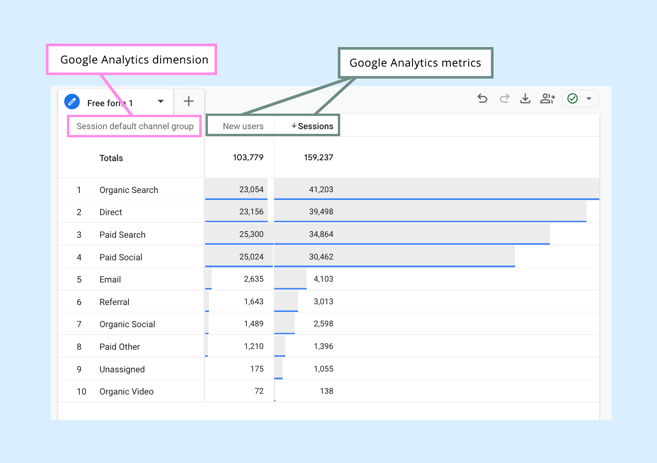Google Analytics Mastery: Introducing the Potential of Secondary Dimension
Google Analytics Mastery: Introducing the Potential of Secondary Dimension
Blog Article
Unlocking the Power of Second Dimension Analytics for Improved Information Insights and Decision-Making
In the realm of information analytics, primary measurements commonly take the spotlight, but the real deepness of insights exists within the world of additional measurements. By utilizing the power of secondary dimension analytics, companies can introduce surprise fads, uncover correlations, and essence more purposeful conclusions from their data.
Importance of Additional Measurements
Discovering the significance of additional dimensions in analytics reveals the concealed layers of information understandings important for notified decision-making in numerous domains. Additional measurements provide a much deeper understanding of main data by offering added context and perspectives. By including secondary measurements into analytics, organizations can extract extra extensive and nuanced insights from their datasets.
One secret relevance of secondary measurements is their capacity to segment and categorize key data, enabling a more detailed analysis of certain subsets within a dataset. This division enables businesses to determine patterns, patterns, and outliers that might not appear when looking at the information overall. Second dimensions assist in discovering relationships and dependencies between various variables, leading to more accurate projecting and predictive modeling - secondary dimension.
In addition, second measurements play a crucial role in enhancing information visualization and reporting. By adding secondary dimensions to visualizations, such as graphes or charts, experts can create a lot more insightful and informative representations of data, promoting much better interaction of searchings for to stakeholders. Generally, the assimilation of secondary measurements in analytics contributes in unlocking the complete potential of data and driving evidence-based decision-making.
Trick Benefits of Using Additional Dimensions
Making use of second dimensions in analytics offers companies a critical advantage by increasing the deepness and granularity of information insights. One crucial advantage of integrating secondary measurements is the capability to sector and filter data, permitting an extra in-depth analysis of specific facets within a dataset. This division makes it possible for organizations to get a much more nuanced understanding of their target market, performance metrics, and other vital information points. By studying data utilizing second dimensions such as time, place, tool kind, or individual demographics, companies can uncover patterns, fads, and connections that might otherwise stay surprise.
Additionally, the application of secondary dimensions improves the context in which primary data is analyzed. By leveraging second dimensions in analytics, organizations can harness the complete capacity of their information to drive far better decision-making and attain their company purposes.
Advanced Information Evaluation Methods
A deep study advanced information evaluation techniques reveals innovative methods for extracting valuable understandings from complicated datasets. One such strategy is artificial intelligence, where formulas are utilized to determine patterns within data, predict end results, and make data-driven choices. This technique permits for the automation of logical design building, allowing the processing of large volumes of data at a much faster speed than conventional techniques.
One more sophisticated technique is anticipating analytics, which uses analytical algorithms and artificial intelligence techniques to forecast future results based upon historical information. By examining trends and right here patterns, organizations can expect customer behavior, market patterns, and possible threats, equipping them to make aggressive choices.
Moreover, text mining and view analysis are beneficial methods for removing understandings from disorganized data sources such as social media remarks, client reviews, and study reactions. By assessing text data, organizations can recognize consumer point of views, identify arising trends, and boost their product and services based upon responses.
Enhancing Decision-Making With Secondary Dimensions

Enhancing decision-making via second measurements allows businesses to make more informed and targeted strategic selections. By segmenting customer data based on second dimensions like acquiring background or engagement degrees, companies can customize their advertising and marketing methods to specific target market sectors, leading to boosted conversion prices and consumer satisfaction. Additionally, additional dimensions can assist determine relationships and connections between different variables, enabling organizations to make data-driven decisions that drive growth and success.
Applying Secondary Dimension Analytics
When incorporating additional dimensions in analytics, companies can open deeper understandings that drive tactical decision-making and enhance general efficiency. Carrying out secondary dimension analytics needs a structured strategy to make certain efficient utilization of this powerful tool. The initial step is to determine the vital metrics and dimensions that align with the organization's critical objectives. This entails recognizing the specific questions the organization seeks to answer and the data factors required to resolve them.

Additionally, organizations must leverage website link progressed analytics tools and modern technologies to simplify the procedure of integrating second measurements. These devices can automate information handling, evaluation, and visualization, allowing organizations to concentrate on analyzing insights as opposed to hand-operated data control.
Conclusion
In verdict, secondary dimension analytics play a vital role in enhancing data understandings and decision-making procedures. By making use of sophisticated information evaluation strategies and executing second measurements properly, companies can unlock the power of their information to drive calculated service decisions.
In the realm of information analytics, key dimensions often take the limelight, but the true deepness of understandings lies within the world of additional measurements.Utilizing additional dimensions in analytics offers organizations a tactical advantage by enhancing the depth and granularity of information understandings. By leveraging secondary measurements in analytics, companies can harness the full capacity of their information to drive better decision-making and accomplish their business objectives.
Implementing information validation procedures and routine audits can aid keep information high quality and dependability.
By making use of innovative data evaluation strategies and implementing additional dimensions effectively, organizations can unlock the power of their information to drive calculated business decisions.
Report this page